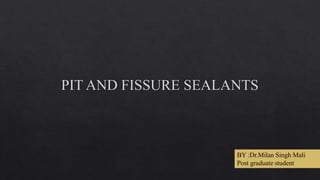Pit and fissure sealants
- 1. BY :Dr.Milan Singh Mali Post graduate student
- 6. In the 1960s a mixture of cyanoacrylate, polymethylmethacrylate and an inorganic powder was used as a sealing material
- 7. Pits and Fissures are enamel faults narrow shafts or cracks of some length whose blind end are directed more or less towards the dentinoenamel junction Grooves are the linear depression form by perfect joining of different lobes On the basis of shape Nango (1960) in his studies shown 4 principal types of fissures V shape U shape I shape K type
- 8. The shallow wide tends to be self cleansable and somewhat caries resistant Deep narrow I shape fissure are quite constricted and resemble a bottleneck .They have a narrow slit like opening with a larger base which extend towards DEJ
- 16. Primary molar sealant application First permanent molar Second permanent molars
- 23. First, a narrow zone of enamel is removed by etching In this plaque and pellicles are dissolved This zone is 10 μm in depth The second zone is qualitative porous zone, which is 20 μm in depth. Because of the porosities created, this zone may be distinguished qualitatively from enamel by polarized light microscopy. The third zone is quantitative porous zone with small porosities and is 20 μm deep.
- 30. Garcia Godoy (1997) found out that all the fluoridated sealant had the greatest amount of fluoride release by 24 hours after mixing and the fluoride release declined sharply thereafter. Cooley et al. (1990) and Hicks et al. (1992) conducted lab studies and concluded that fluoride release dips considerably as the days go by. But, they showed that 60 percent reduction in secondary caries and enhanced degree of caries resistance was seen.
- 31. This type of sealant is esthetic and difficult to detect in recall visit The sealant is clear to begin with but after polymerization it changes its color. The degree of color change is also an indicator of its setting and adequate polymerization . Easy to see during placement and recall
- 32. Through the use of a UV pen light, this sealant fluoresces a blue/white color The fluorescent glow provides clinicians with a visual verification of the sealant margins at the time of placement and offers the easiest way to verify retention and inspect margins during patient recall appointments This is the first pit and fissure sealant resin that can be applied in a moist field. It forms a unique resin acid-integrating network (RAIN) that improves penetration into pits and fissures and provides superior sealing of the margins. It bonds chemically and micromechanically to the moist tooth, integrating with the tooth structure to create a strong, margin-free bond that virtually eliminates microleakage.
- 33. It is a light-cured sealant that contains the “smart material” amorphous calcium phosphate (ACP) that is more resilient and flexible, creating a stronger, long lasting sealant. ACP is referred to as a “smart material” because it only releases calcium and phosphate ions when the pH drops to 5.9. Once the calcium phosphate is released, it will act to neutralize the acid and buffer the PH. ACP acts as reinforcement to the tooth’s natural defense system only when it is needed This is a new sealant developed which combines the best properties of nearly all sealants. Some of its major properties are hydrophilic chemistry, advanced adhesive technology, fluorescent properties, thixotrophic viscosity, BPA-free formula.


































